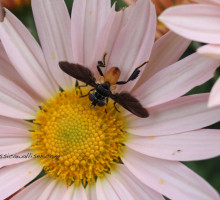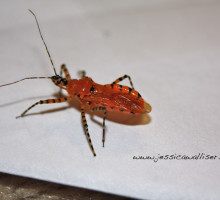
I found this beautiful fly sipping nectar from a perennial mum in my garden yesterday. A member of the tachinid fly family, Trichopoda pennipes (aka the feather-legged fly) is a very beneficial insect to have around. Tachinid flies are parasitoids that use many different insects as hosts for their developing young, and the feather-legged fly is no different. Female feather-legged flies lay tiny, pale-colored, oval eggs on true bugs, including squash bugs, stink bugs (!!!), and leaf-footed bugs. The eggs hatch, and the resulting larvae burrow down into the host insect and consume it as they develop through several instars, eventually bringing death to the host. Pupation takes place in the soil. Trichopoda pennipes produces two to three generations per year, and each female fly can lay several hundred eggs. Clearly, they are a valuable insect to have in the vegetable garden. Adult flies feed on pollen and nectar, particularly from members of the aster family. In my own garden, I frequently find them on my boltonia, black eyed Susans, coreopsis, yarrow, and asters. The feather-legged fly in this photo is a male, as evidenced by its orange abdomen (females have brown abdomens)

This beautiful orange creature is an assassin bug in the family Reduviidae. Pselliopsus barberi is one of over 100 species of assassin bugs in North America, and if there were a ninja of the insect world, this dude would be it. The aptly named assassin bug is sneaky, swift, vicious, and deadly. It uses a sharp, curved mouthpart (called a rostrum) to pierce insect prey and inject it with a lethal toxin before slurping up its innards. It might sound gross until you consider who this insect is having for lunch. Common prey include garden pests like hornworms, Mexican bean beetles, Colorado potato beetles, leafhoppers, aphids, caterpillars of all sorts, cucumber beetles, and many others. Adult assassin bugs can measure from 0.5–1.0 in. (13–25 mm) in length, depending on the species. Some species, like this one, are brightly colored, but most assassin bugs are brown, green, or black. They have broad bodies, elongated heads, and long, spindly legs. Females lay eggs on plants and the resulting nymphs (with their distinctive sway-backs) pass through several stages before fully maturing. Both adults and nymphs are covert little buggers and aren’t usually encountered by gardeners on a regular basis. At best, I come across one or two each season